Cloud Solutions & Online Study Materials: A Business Analysis Report
VerifiedAdded on 2023/06/13
|18
|5001
|473
Report
AI Summary
This report presents a business analysis of World Education, focusing on two key ICT initiatives: cloud-based solutions and online study materials. It details the business overview, objectives, and SWOT analysis for each initiative. The report identifies legislative and organizational requirements, including compliance with GDPR, Corporation Act 2001, and Privacy Act 1988. Stakeholder analysis is conducted using techniques like affinity diagrams and power/interest grids to identify and manage internal and external stakeholders. Organizational process needs are established, incorporating personnel engagement and project management methodologies such as Agile. The execution plan includes feasibility studies, stakeholder analysis, and resource allocation for both cloud-based solutions and online study material initiatives, ensuring effective utilization of ICT resources.

CONTENTS
Paraphrase This Document
Need a fresh take? Get an instant paraphrase of this document with our AI Paraphraser
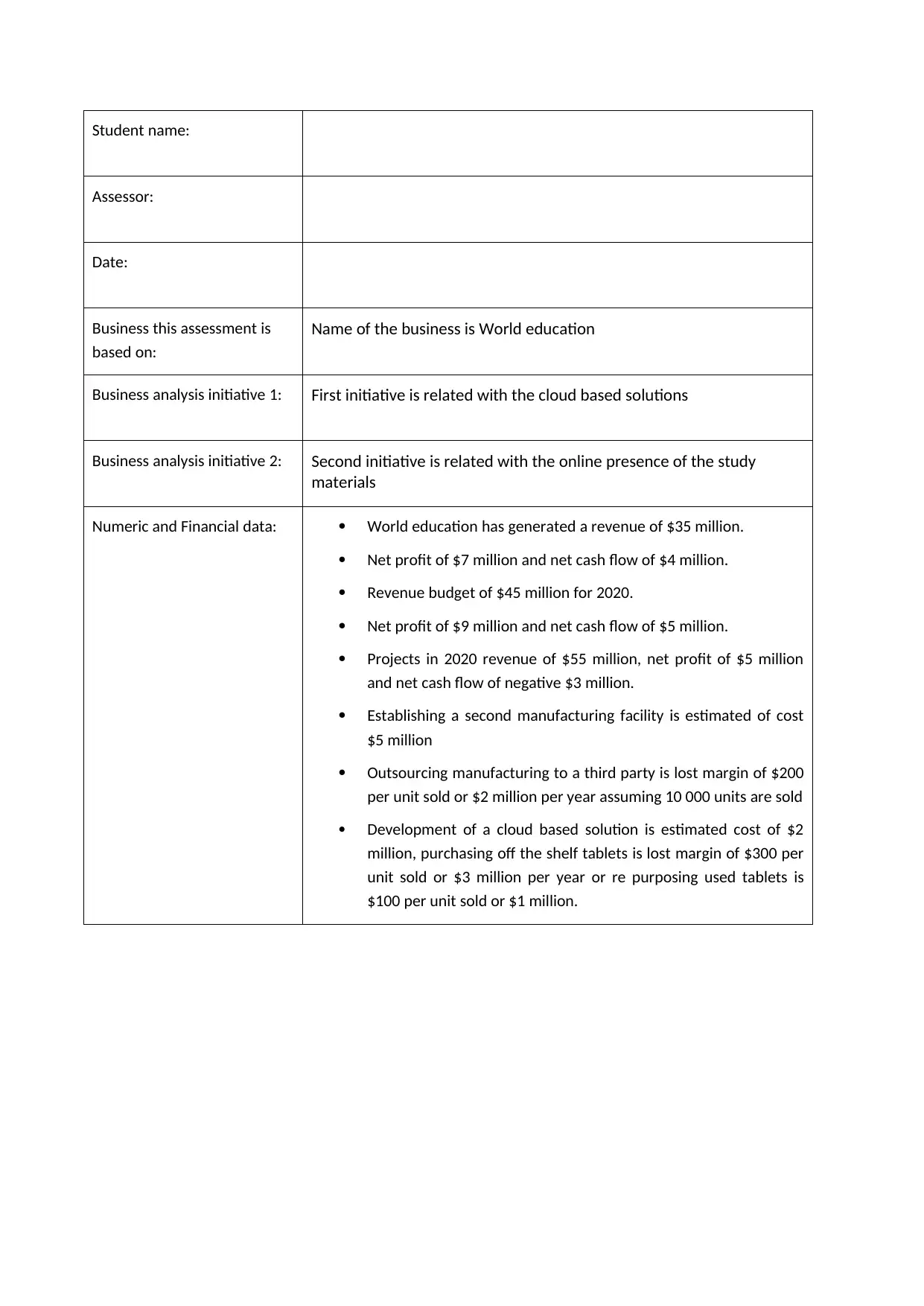
Student name:
Assessor:
Date:
Business this assessment is
based on:
Name of the business is World education
Business analysis initiative 1: First initiative is related with the cloud based solutions
Business analysis initiative 2: Second initiative is related with the online presence of the study
materials
Numeric and Financial data: World education has generated a revenue of $35 million.
Net profit of $7 million and net cash flow of $4 million.
Revenue budget of $45 million for 2020.
Net profit of $9 million and net cash flow of $5 million.
Projects in 2020 revenue of $55 million, net profit of $5 million
and net cash flow of negative $3 million.
Establishing a second manufacturing facility is estimated of cost
$5 million
Outsourcing manufacturing to a third party is lost margin of $200
per unit sold or $2 million per year assuming 10 000 units are sold
Development of a cloud based solution is estimated cost of $2
million, purchasing off the shelf tablets is lost margin of $300 per
unit sold or $3 million per year or re purposing used tablets is
$100 per unit sold or $1 million.
Assessor:
Date:
Business this assessment is
based on:
Name of the business is World education
Business analysis initiative 1: First initiative is related with the cloud based solutions
Business analysis initiative 2: Second initiative is related with the online presence of the study
materials
Numeric and Financial data: World education has generated a revenue of $35 million.
Net profit of $7 million and net cash flow of $4 million.
Revenue budget of $45 million for 2020.
Net profit of $9 million and net cash flow of $5 million.
Projects in 2020 revenue of $55 million, net profit of $5 million
and net cash flow of negative $3 million.
Establishing a second manufacturing facility is estimated of cost
$5 million
Outsourcing manufacturing to a third party is lost margin of $200
per unit sold or $2 million per year assuming 10 000 units are sold
Development of a cloud based solution is estimated cost of $2
million, purchasing off the shelf tablets is lost margin of $300 per
unit sold or $3 million per year or re purposing used tablets is
$100 per unit sold or $1 million.

Secti on 1: Establish business analysis approach
Provide business
overview
Provide an overview
of the business,
including: name of
business
description of
what the
business does.
Name of the business is Worldeducation.
It is a social startup which deals with the tablet computers
for the school students who are studying at primary level.
They are aiming to develop and introduce the information
and communication technology initiatives. This is because
they are aiming to solve the major problems they are facing
in the business such as maximum imparting education to
the students using technology.
Describe business
analysis initiatives
Describe the two
selected ICT business
analysis initiatives
associated with the
business. Include: a brief outline
of each
initiative,
including:
the type of ICT
project
a description of the
initiative an explanation
of how each
initiative
supports the
organisation’s
vision and
strategy an appropriate
business
analysis tool to
illustrate and
fully define the
initiative (e.g.
SWAT analysis)
two objectives
of each
initiative.
First initiative is related with the cloud based solutions.
Description: Business analysis with the help of cloud based
solutions is defined as the usage of advanced and updated
technical resources over the internet. Company will be
benefited with cloud based solution in performing proper
business analysis in terms of strategic decision making for
the institution. It is also concerned with the security such as
password management in an appropriate authentication
and authorisation access control. Moreover, it helps in the
cost savings with rendering the flexibility and increased
collaboration along with the loss prevention and providing
competitive edge as well. It also aids in sustainability and
automatic software updates.
SWOT analysis of cloud based solutions is such that its
strength includes that it has compliant facilities and secured
infrastructure along with the cost efficiency and friendly
utilisation. Weaknesses includes that its requires post
training and the increased dependency along with the data
transfer bottlenecks and issues in integration with local
software. Opportunities includes that it can invent the
scalable store and quick resolution of problems along with
the standardised process and also adaptive future needs.
Threats includes the security concerns and hidden cost
along with the compatibility reduction and difficulty in
migration from one platform to another.
Second initiative is related with the online presence of the
study materials.
Description: Business analysis with the help of online
presence of study materials is a assist the company in
analysing the relevant data about what materials can be
more effective and what format is likes by the students
more. This is to analyse the level of awareness of such
platforms and creating the audio, video, text and image
format to display the notes in a more entertainment
manner for the students. It helps students to explore more
Provide business
overview
Provide an overview
of the business,
including: name of
business
description of
what the
business does.
Name of the business is Worldeducation.
It is a social startup which deals with the tablet computers
for the school students who are studying at primary level.
They are aiming to develop and introduce the information
and communication technology initiatives. This is because
they are aiming to solve the major problems they are facing
in the business such as maximum imparting education to
the students using technology.
Describe business
analysis initiatives
Describe the two
selected ICT business
analysis initiatives
associated with the
business. Include: a brief outline
of each
initiative,
including:
the type of ICT
project
a description of the
initiative an explanation
of how each
initiative
supports the
organisation’s
vision and
strategy an appropriate
business
analysis tool to
illustrate and
fully define the
initiative (e.g.
SWAT analysis)
two objectives
of each
initiative.
First initiative is related with the cloud based solutions.
Description: Business analysis with the help of cloud based
solutions is defined as the usage of advanced and updated
technical resources over the internet. Company will be
benefited with cloud based solution in performing proper
business analysis in terms of strategic decision making for
the institution. It is also concerned with the security such as
password management in an appropriate authentication
and authorisation access control. Moreover, it helps in the
cost savings with rendering the flexibility and increased
collaboration along with the loss prevention and providing
competitive edge as well. It also aids in sustainability and
automatic software updates.
SWOT analysis of cloud based solutions is such that its
strength includes that it has compliant facilities and secured
infrastructure along with the cost efficiency and friendly
utilisation. Weaknesses includes that its requires post
training and the increased dependency along with the data
transfer bottlenecks and issues in integration with local
software. Opportunities includes that it can invent the
scalable store and quick resolution of problems along with
the standardised process and also adaptive future needs.
Threats includes the security concerns and hidden cost
along with the compatibility reduction and difficulty in
migration from one platform to another.
Second initiative is related with the online presence of the
study materials.
Description: Business analysis with the help of online
presence of study materials is a assist the company in
analysing the relevant data about what materials can be
more effective and what format is likes by the students
more. This is to analyse the level of awareness of such
platforms and creating the audio, video, text and image
format to display the notes in a more entertainment
manner for the students. It helps students to explore more
⊘ This is a preview!⊘
Do you want full access?
Subscribe today to unlock all pages.

Trusted by 1+ million students worldwide
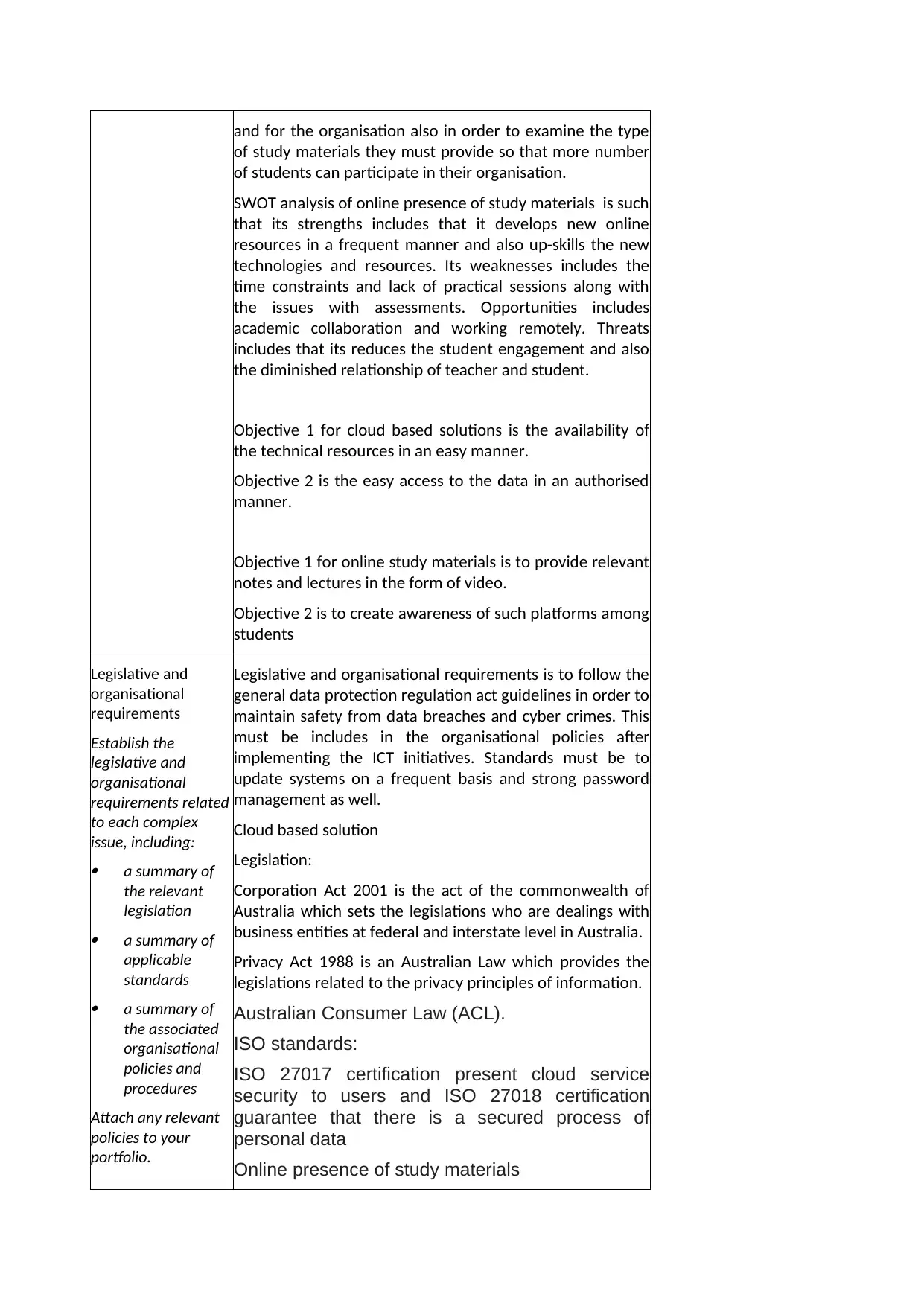
and for the organisation also in order to examine the type
of study materials they must provide so that more number
of students can participate in their organisation.
SWOT analysis of online presence of study materials is such
that its strengths includes that it develops new online
resources in a frequent manner and also up-skills the new
technologies and resources. Its weaknesses includes the
time constraints and lack of practical sessions along with
the issues with assessments. Opportunities includes
academic collaboration and working remotely. Threats
includes that its reduces the student engagement and also
the diminished relationship of teacher and student.
Objective 1 for cloud based solutions is the availability of
the technical resources in an easy manner.
Objective 2 is the easy access to the data in an authorised
manner.
Objective 1 for online study materials is to provide relevant
notes and lectures in the form of video.
Objective 2 is to create awareness of such platforms among
students
Legislative and
organisational
requirements
Establish the
legislative and
organisational
requirements related
to each complex
issue, including: a summary of
the relevant
legislation a summary of
applicable
standards a summary of
the associated
organisational
policies and
procedures
Attach any relevant
policies to your
portfolio.
Legislative and organisational requirements is to follow the
general data protection regulation act guidelines in order to
maintain safety from data breaches and cyber crimes. This
must be includes in the organisational policies after
implementing the ICT initiatives. Standards must be to
update systems on a frequent basis and strong password
management as well.
Cloud based solution
Legislation:
Corporation Act 2001 is the act of the commonwealth of
Australia which sets the legislations who are dealings with
business entities at federal and interstate level in Australia.
Privacy Act 1988 is an Australian Law which provides the
legislations related to the privacy principles of information.
Australian Consumer Law (ACL).
ISO standards:
ISO 27017 certification present cloud service
security to users and ISO 27018 certification
guarantee that there is a secured process of
personal data
Online presence of study materials
of study materials they must provide so that more number
of students can participate in their organisation.
SWOT analysis of online presence of study materials is such
that its strengths includes that it develops new online
resources in a frequent manner and also up-skills the new
technologies and resources. Its weaknesses includes the
time constraints and lack of practical sessions along with
the issues with assessments. Opportunities includes
academic collaboration and working remotely. Threats
includes that its reduces the student engagement and also
the diminished relationship of teacher and student.
Objective 1 for cloud based solutions is the availability of
the technical resources in an easy manner.
Objective 2 is the easy access to the data in an authorised
manner.
Objective 1 for online study materials is to provide relevant
notes and lectures in the form of video.
Objective 2 is to create awareness of such platforms among
students
Legislative and
organisational
requirements
Establish the
legislative and
organisational
requirements related
to each complex
issue, including: a summary of
the relevant
legislation a summary of
applicable
standards a summary of
the associated
organisational
policies and
procedures
Attach any relevant
policies to your
portfolio.
Legislative and organisational requirements is to follow the
general data protection regulation act guidelines in order to
maintain safety from data breaches and cyber crimes. This
must be includes in the organisational policies after
implementing the ICT initiatives. Standards must be to
update systems on a frequent basis and strong password
management as well.
Cloud based solution
Legislation:
Corporation Act 2001 is the act of the commonwealth of
Australia which sets the legislations who are dealings with
business entities at federal and interstate level in Australia.
Privacy Act 1988 is an Australian Law which provides the
legislations related to the privacy principles of information.
Australian Consumer Law (ACL).
ISO standards:
ISO 27017 certification present cloud service
security to users and ISO 27018 certification
guarantee that there is a secured process of
personal data
Online presence of study materials
Paraphrase This Document
Need a fresh take? Get an instant paraphrase of this document with our AI Paraphraser
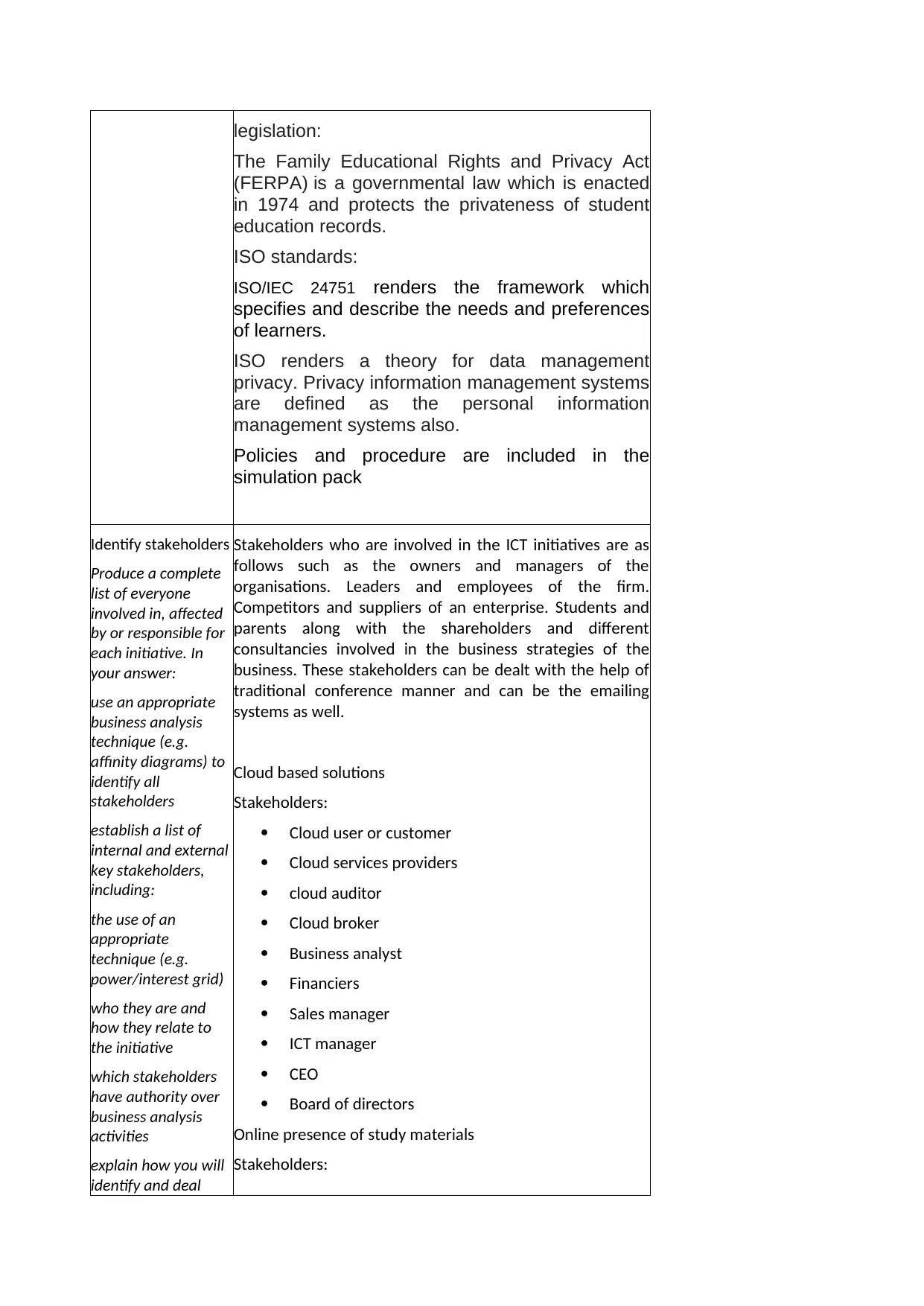
legislation:
The Family Educational Rights and Privacy Act
(FERPA) is a governmental law which is enacted
in 1974 and protects the privateness of student
education records.
ISO standards:
ISO/IEC 24751 renders the framework which
specifies and describe the needs and preferences
of learners.
ISO renders a theory for data management
privacy. Privacy information management systems
are defined as the personal information
management systems also.
Policies and procedure are included in the
simulation pack
Identify stakeholders
Produce a complete
list of everyone
involved in, affected
by or responsible for
each initiative. In
your answer:
use an appropriate
business analysis
technique (e.g.
affinity diagrams) to
identify all
stakeholders
establish a list of
internal and external
key stakeholders,
including:
the use of an
appropriate
technique (e.g.
power/interest grid)
who they are and
how they relate to
the initiative
which stakeholders
have authority over
business analysis
activities
explain how you will
identify and deal
Stakeholders who are involved in the ICT initiatives are as
follows such as the owners and managers of the
organisations. Leaders and employees of the firm.
Competitors and suppliers of an enterprise. Students and
parents along with the shareholders and different
consultancies involved in the business strategies of the
business. These stakeholders can be dealt with the help of
traditional conference manner and can be the emailing
systems as well.
Cloud based solutions
Stakeholders:
Cloud user or customer
Cloud services providers
cloud auditor
Cloud broker
Business analyst
Financiers
Sales manager
ICT manager
CEO
Board of directors
Online presence of study materials
Stakeholders:
The Family Educational Rights and Privacy Act
(FERPA) is a governmental law which is enacted
in 1974 and protects the privateness of student
education records.
ISO standards:
ISO/IEC 24751 renders the framework which
specifies and describe the needs and preferences
of learners.
ISO renders a theory for data management
privacy. Privacy information management systems
are defined as the personal information
management systems also.
Policies and procedure are included in the
simulation pack
Identify stakeholders
Produce a complete
list of everyone
involved in, affected
by or responsible for
each initiative. In
your answer:
use an appropriate
business analysis
technique (e.g.
affinity diagrams) to
identify all
stakeholders
establish a list of
internal and external
key stakeholders,
including:
the use of an
appropriate
technique (e.g.
power/interest grid)
who they are and
how they relate to
the initiative
which stakeholders
have authority over
business analysis
activities
explain how you will
identify and deal
Stakeholders who are involved in the ICT initiatives are as
follows such as the owners and managers of the
organisations. Leaders and employees of the firm.
Competitors and suppliers of an enterprise. Students and
parents along with the shareholders and different
consultancies involved in the business strategies of the
business. These stakeholders can be dealt with the help of
traditional conference manner and can be the emailing
systems as well.
Cloud based solutions
Stakeholders:
Cloud user or customer
Cloud services providers
cloud auditor
Cloud broker
Business analyst
Financiers
Sales manager
ICT manager
CEO
Board of directors
Online presence of study materials
Stakeholders:
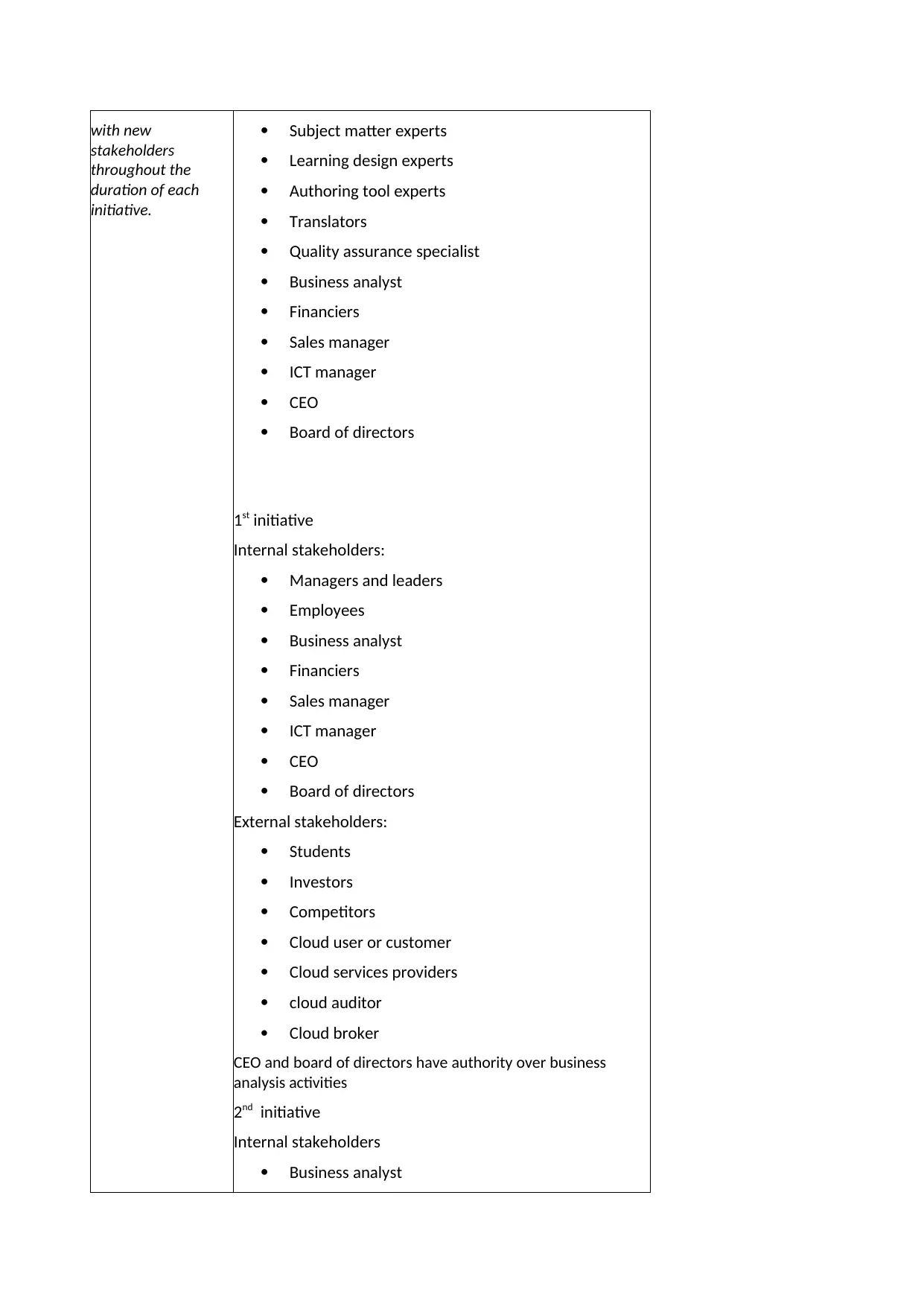
with new
stakeholders
throughout the
duration of each
initiative.
Subject matter experts
Learning design experts
Authoring tool experts
Translators
Quality assurance specialist
Business analyst
Financiers
Sales manager
ICT manager
CEO
Board of directors
1st initiative
Internal stakeholders:
Managers and leaders
Employees
Business analyst
Financiers
Sales manager
ICT manager
CEO
Board of directors
External stakeholders:
Students
Investors
Competitors
Cloud user or customer
Cloud services providers
cloud auditor
Cloud broker
CEO and board of directors have authority over business
analysis activities
2nd initiative
Internal stakeholders
Business analyst
stakeholders
throughout the
duration of each
initiative.
Subject matter experts
Learning design experts
Authoring tool experts
Translators
Quality assurance specialist
Business analyst
Financiers
Sales manager
ICT manager
CEO
Board of directors
1st initiative
Internal stakeholders:
Managers and leaders
Employees
Business analyst
Financiers
Sales manager
ICT manager
CEO
Board of directors
External stakeholders:
Students
Investors
Competitors
Cloud user or customer
Cloud services providers
cloud auditor
Cloud broker
CEO and board of directors have authority over business
analysis activities
2nd initiative
Internal stakeholders
Business analyst
⊘ This is a preview!⊘
Do you want full access?
Subscribe today to unlock all pages.

Trusted by 1+ million students worldwide
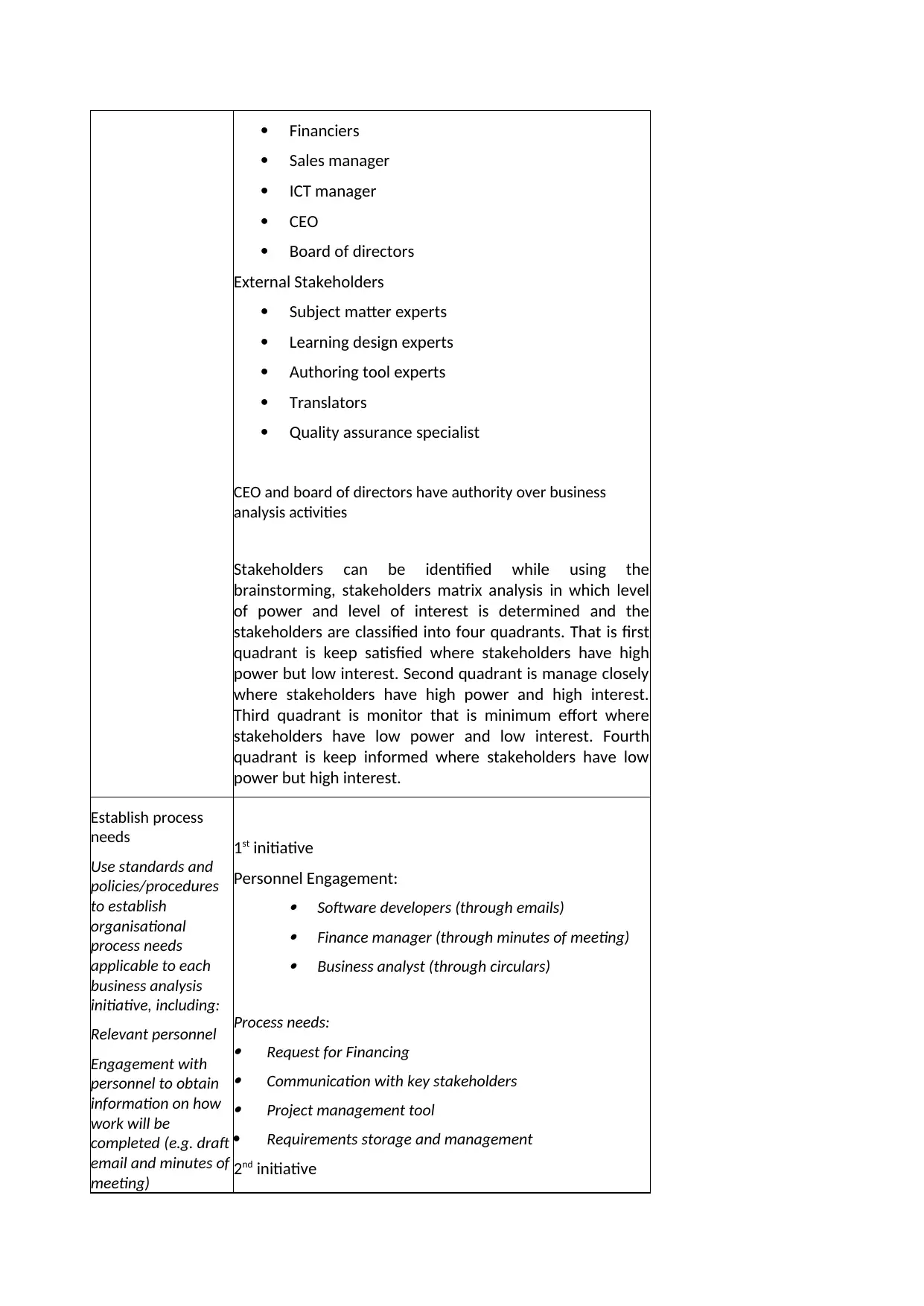
Financiers
Sales manager
ICT manager
CEO
Board of directors
External Stakeholders
Subject matter experts
Learning design experts
Authoring tool experts
Translators
Quality assurance specialist
CEO and board of directors have authority over business
analysis activities
Stakeholders can be identified while using the
brainstorming, stakeholders matrix analysis in which level
of power and level of interest is determined and the
stakeholders are classified into four quadrants. That is first
quadrant is keep satisfied where stakeholders have high
power but low interest. Second quadrant is manage closely
where stakeholders have high power and high interest.
Third quadrant is monitor that is minimum effort where
stakeholders have low power and low interest. Fourth
quadrant is keep informed where stakeholders have low
power but high interest.
Establish process
needs
Use standards and
policies/procedures
to establish
organisational
process needs
applicable to each
business analysis
initiative, including:
Relevant personnel
Engagement with
personnel to obtain
information on how
work will be
completed (e.g. draft
email and minutes of
meeting)
1st initiative
Personnel Engagement:
Software developers (through emails)
Finance manager (through minutes of meeting)
Business analyst (through circulars)
Process needs:
Request for Financing
Communication with key stakeholders
Project management tool
Requirements storage and management
2nd initiative
Sales manager
ICT manager
CEO
Board of directors
External Stakeholders
Subject matter experts
Learning design experts
Authoring tool experts
Translators
Quality assurance specialist
CEO and board of directors have authority over business
analysis activities
Stakeholders can be identified while using the
brainstorming, stakeholders matrix analysis in which level
of power and level of interest is determined and the
stakeholders are classified into four quadrants. That is first
quadrant is keep satisfied where stakeholders have high
power but low interest. Second quadrant is manage closely
where stakeholders have high power and high interest.
Third quadrant is monitor that is minimum effort where
stakeholders have low power and low interest. Fourth
quadrant is keep informed where stakeholders have low
power but high interest.
Establish process
needs
Use standards and
policies/procedures
to establish
organisational
process needs
applicable to each
business analysis
initiative, including:
Relevant personnel
Engagement with
personnel to obtain
information on how
work will be
completed (e.g. draft
email and minutes of
meeting)
1st initiative
Personnel Engagement:
Software developers (through emails)
Finance manager (through minutes of meeting)
Business analyst (through circulars)
Process needs:
Request for Financing
Communication with key stakeholders
Project management tool
Requirements storage and management
2nd initiative
Paraphrase This Document
Need a fresh take? Get an instant paraphrase of this document with our AI Paraphraser

A description of an
appropriate project
management
method or tool to
support the business
analysis initiative.
Attach proof of
engagement with
staff to your
portfolio.
Personnel Engagement:
Software developers (through emails)
Finance manager (through minutes of meeting)
Business analyst (through circulars)
Process needs for 2ndinitative
Software developers
Following software development life cycle
Code testing and error rectification
Maintenance and security
Project management which can highly support the current
initiatives of ITC can be the agile project management
methodology. This is because each and every phase of the
project management must be reviewed and tested until it is
rectified. That is why it is also known as the iterative form
of project management.
Plan execution of
activities
Plan the execution of
business analysis
activities according
to organisational
requirements for
each initiative.
Execution of the plan can be initiated by gathering all the
requirements for the cloud based solutions and online
platforms. Feasibility study must be conducted for the same
so that the optimum utilisation of the ICT resources can be
done in an effective and efficient manner.
1st initiative
Creating a business analysis plan
Conducting stakeholder analysis and form a
stakeholder management plan
Performing feasibility study which includes the time
and scope along with the budget and resources
feasibility.
2nd initiative
Creating a business analysis plan
Conducting stakeholder analysis and form a
stakeholder management plan
Performing feasibility study which includes the time
and scope along with the budget and resources
feasibility
(Initiative 1
Business analysis plan for the cloud based solutions is such
that the business first conduct the time and cost
appropriate project
management
method or tool to
support the business
analysis initiative.
Attach proof of
engagement with
staff to your
portfolio.
Personnel Engagement:
Software developers (through emails)
Finance manager (through minutes of meeting)
Business analyst (through circulars)
Process needs for 2ndinitative
Software developers
Following software development life cycle
Code testing and error rectification
Maintenance and security
Project management which can highly support the current
initiatives of ITC can be the agile project management
methodology. This is because each and every phase of the
project management must be reviewed and tested until it is
rectified. That is why it is also known as the iterative form
of project management.
Plan execution of
activities
Plan the execution of
business analysis
activities according
to organisational
requirements for
each initiative.
Execution of the plan can be initiated by gathering all the
requirements for the cloud based solutions and online
platforms. Feasibility study must be conducted for the same
so that the optimum utilisation of the ICT resources can be
done in an effective and efficient manner.
1st initiative
Creating a business analysis plan
Conducting stakeholder analysis and form a
stakeholder management plan
Performing feasibility study which includes the time
and scope along with the budget and resources
feasibility.
2nd initiative
Creating a business analysis plan
Conducting stakeholder analysis and form a
stakeholder management plan
Performing feasibility study which includes the time
and scope along with the budget and resources
feasibility
(Initiative 1
Business analysis plan for the cloud based solutions is such
that the business first conduct the time and cost

constraints. Then implement according to the available
human and technical resources. Stakeholder analysis is
done with the help of examining the optimised resources
required as per the internal and external stakeholders.
Activities includes are the cloud discovery and cloud data
migration along with the cloud data maturity and cloud
data leader.
Initiative 2
Business analysis plan for the online presence of study
materials is such as feasibility study is conducted for the
resources required so that availability can be there for the
resources at the time of execution. Moreover, creating
awareness must also be performed so that maximum
participation can be done by the users. Stakeholder analysis
is performed by proper identification of the shareholder
and investors so that the return on investment can be
estimated at maximum level. Activities includes are the
software development and including the study materials in
different formats then advertising for the same.
Attach: Organisational policies and procedures ☐
Legislation ☐
Standards ☐
Proof of engagement with satff ☐
human and technical resources. Stakeholder analysis is
done with the help of examining the optimised resources
required as per the internal and external stakeholders.
Activities includes are the cloud discovery and cloud data
migration along with the cloud data maturity and cloud
data leader.
Initiative 2
Business analysis plan for the online presence of study
materials is such as feasibility study is conducted for the
resources required so that availability can be there for the
resources at the time of execution. Moreover, creating
awareness must also be performed so that maximum
participation can be done by the users. Stakeholder analysis
is performed by proper identification of the shareholder
and investors so that the return on investment can be
estimated at maximum level. Activities includes are the
software development and including the study materials in
different formats then advertising for the same.
Attach: Organisational policies and procedures ☐
Legislation ☐
Standards ☐
Proof of engagement with satff ☐
⊘ This is a preview!⊘
Do you want full access?
Subscribe today to unlock all pages.

Trusted by 1+ million students worldwide
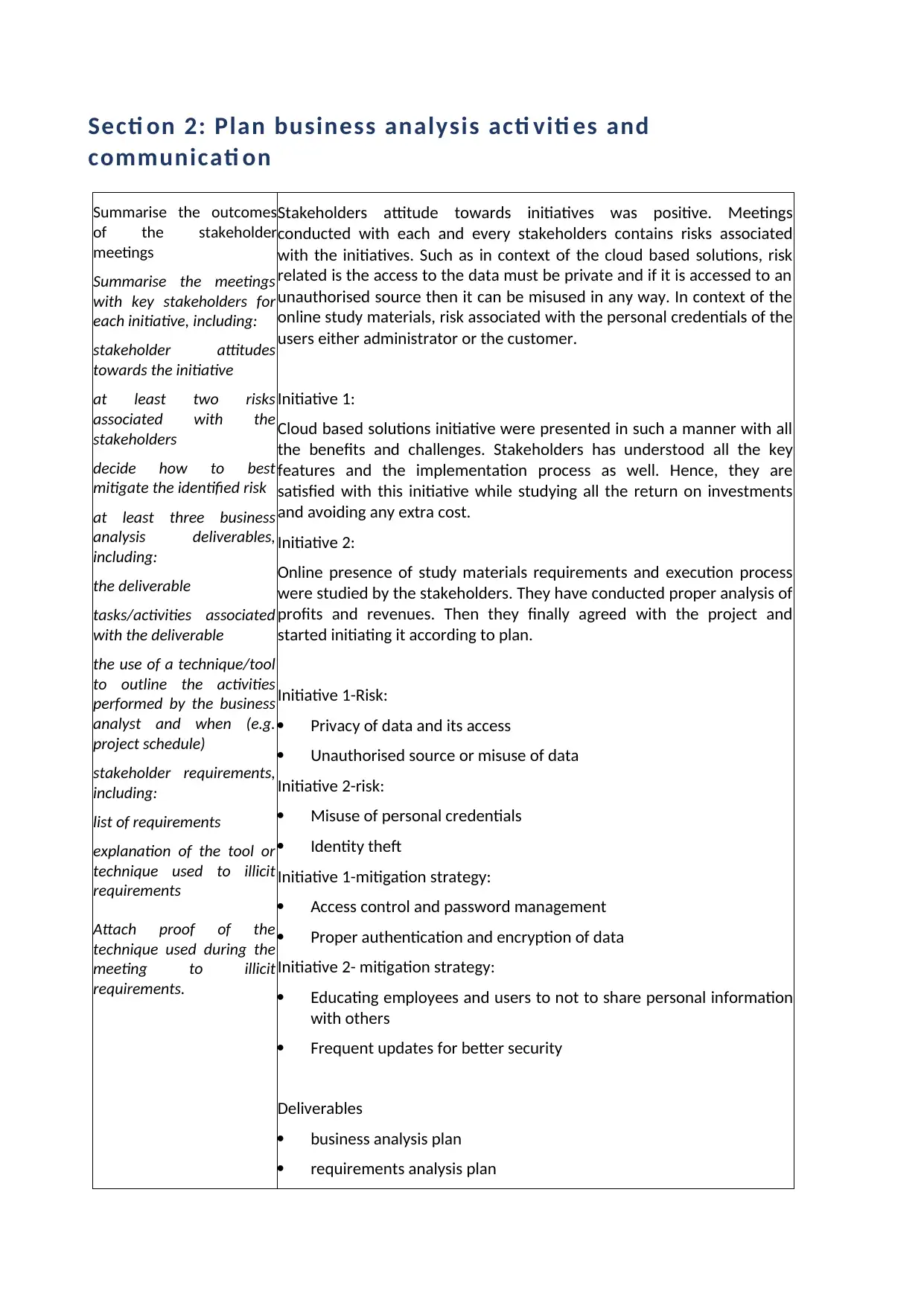
Secti on 2: Plan business analysis acti viti es and
communicati on
Summarise the outcomes
of the stakeholder
meetings
Summarise the meetings
with key stakeholders for
each initiative, including:
stakeholder attitudes
towards the initiative
at least two risks
associated with the
stakeholders
decide how to best
mitigate the identified risk
at least three business
analysis deliverables,
including:
the deliverable
tasks/activities associated
with the deliverable
the use of a technique/tool
to outline the activities
performed by the business
analyst and when (e.g.
project schedule)
stakeholder requirements,
including:
list of requirements
explanation of the tool or
technique used to illicit
requirements
Attach proof of the
technique used during the
meeting to illicit
requirements.
Stakeholders attitude towards initiatives was positive. Meetings
conducted with each and every stakeholders contains risks associated
with the initiatives. Such as in context of the cloud based solutions, risk
related is the access to the data must be private and if it is accessed to an
unauthorised source then it can be misused in any way. In context of the
online study materials, risk associated with the personal credentials of the
users either administrator or the customer.
Initiative 1:
Cloud based solutions initiative were presented in such a manner with all
the benefits and challenges. Stakeholders has understood all the key
features and the implementation process as well. Hence, they are
satisfied with this initiative while studying all the return on investments
and avoiding any extra cost.
Initiative 2:
Online presence of study materials requirements and execution process
were studied by the stakeholders. They have conducted proper analysis of
profits and revenues. Then they finally agreed with the project and
started initiating it according to plan.
Initiative 1-Risk:
Privacy of data and its access
Unauthorised source or misuse of data
Initiative 2-risk:
Misuse of personal credentials
Identity theft
Initiative 1-mitigation strategy:
Access control and password management
Proper authentication and encryption of data
Initiative 2- mitigation strategy:
Educating employees and users to not to share personal information
with others
Frequent updates for better security
Deliverables
business analysis plan
requirements analysis plan
communicati on
Summarise the outcomes
of the stakeholder
meetings
Summarise the meetings
with key stakeholders for
each initiative, including:
stakeholder attitudes
towards the initiative
at least two risks
associated with the
stakeholders
decide how to best
mitigate the identified risk
at least three business
analysis deliverables,
including:
the deliverable
tasks/activities associated
with the deliverable
the use of a technique/tool
to outline the activities
performed by the business
analyst and when (e.g.
project schedule)
stakeholder requirements,
including:
list of requirements
explanation of the tool or
technique used to illicit
requirements
Attach proof of the
technique used during the
meeting to illicit
requirements.
Stakeholders attitude towards initiatives was positive. Meetings
conducted with each and every stakeholders contains risks associated
with the initiatives. Such as in context of the cloud based solutions, risk
related is the access to the data must be private and if it is accessed to an
unauthorised source then it can be misused in any way. In context of the
online study materials, risk associated with the personal credentials of the
users either administrator or the customer.
Initiative 1:
Cloud based solutions initiative were presented in such a manner with all
the benefits and challenges. Stakeholders has understood all the key
features and the implementation process as well. Hence, they are
satisfied with this initiative while studying all the return on investments
and avoiding any extra cost.
Initiative 2:
Online presence of study materials requirements and execution process
were studied by the stakeholders. They have conducted proper analysis of
profits and revenues. Then they finally agreed with the project and
started initiating it according to plan.
Initiative 1-Risk:
Privacy of data and its access
Unauthorised source or misuse of data
Initiative 2-risk:
Misuse of personal credentials
Identity theft
Initiative 1-mitigation strategy:
Access control and password management
Proper authentication and encryption of data
Initiative 2- mitigation strategy:
Educating employees and users to not to share personal information
with others
Frequent updates for better security
Deliverables
business analysis plan
requirements analysis plan
Paraphrase This Document
Need a fresh take? Get an instant paraphrase of this document with our AI Paraphraser
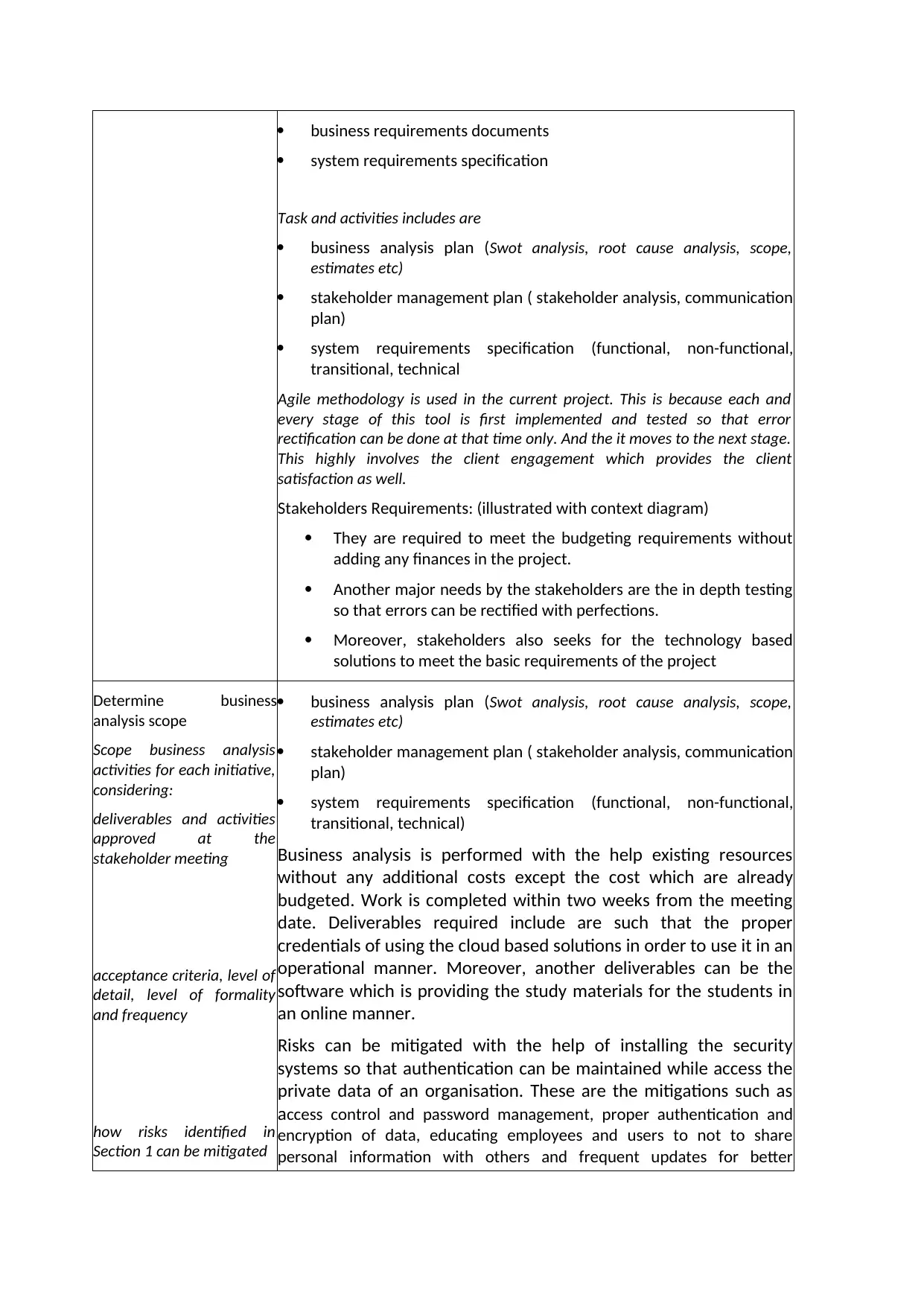
business requirements documents
system requirements specification
Task and activities includes are
business analysis plan (Swot analysis, root cause analysis, scope,
estimates etc)
stakeholder management plan ( stakeholder analysis, communication
plan)
system requirements specification (functional, non-functional,
transitional, technical
Agile methodology is used in the current project. This is because each and
every stage of this tool is first implemented and tested so that error
rectification can be done at that time only. And the it moves to the next stage.
This highly involves the client engagement which provides the client
satisfaction as well.
Stakeholders Requirements: (illustrated with context diagram)
They are required to meet the budgeting requirements without
adding any finances in the project.
Another major needs by the stakeholders are the in depth testing
so that errors can be rectified with perfections.
Moreover, stakeholders also seeks for the technology based
solutions to meet the basic requirements of the project
Determine business
analysis scope
Scope business analysis
activities for each initiative,
considering:
deliverables and activities
approved at the
stakeholder meeting
acceptance criteria, level of
detail, level of formality
and frequency
how risks identified in
Section 1 can be mitigated
business analysis plan (Swot analysis, root cause analysis, scope,
estimates etc)
stakeholder management plan ( stakeholder analysis, communication
plan)
system requirements specification (functional, non-functional,
transitional, technical)
Business analysis is performed with the help existing resources
without any additional costs except the cost which are already
budgeted. Work is completed within two weeks from the meeting
date. Deliverables required include are such that the proper
credentials of using the cloud based solutions in order to use it in an
operational manner. Moreover, another deliverables can be the
software which is providing the study materials for the students in
an online manner.
Risks can be mitigated with the help of installing the security
systems so that authentication can be maintained while access the
private data of an organisation. These are the mitigations such as
access control and password management, proper authentication and
encryption of data, educating employees and users to not to share
personal information with others and frequent updates for better
system requirements specification
Task and activities includes are
business analysis plan (Swot analysis, root cause analysis, scope,
estimates etc)
stakeholder management plan ( stakeholder analysis, communication
plan)
system requirements specification (functional, non-functional,
transitional, technical
Agile methodology is used in the current project. This is because each and
every stage of this tool is first implemented and tested so that error
rectification can be done at that time only. And the it moves to the next stage.
This highly involves the client engagement which provides the client
satisfaction as well.
Stakeholders Requirements: (illustrated with context diagram)
They are required to meet the budgeting requirements without
adding any finances in the project.
Another major needs by the stakeholders are the in depth testing
so that errors can be rectified with perfections.
Moreover, stakeholders also seeks for the technology based
solutions to meet the basic requirements of the project
Determine business
analysis scope
Scope business analysis
activities for each initiative,
considering:
deliverables and activities
approved at the
stakeholder meeting
acceptance criteria, level of
detail, level of formality
and frequency
how risks identified in
Section 1 can be mitigated
business analysis plan (Swot analysis, root cause analysis, scope,
estimates etc)
stakeholder management plan ( stakeholder analysis, communication
plan)
system requirements specification (functional, non-functional,
transitional, technical)
Business analysis is performed with the help existing resources
without any additional costs except the cost which are already
budgeted. Work is completed within two weeks from the meeting
date. Deliverables required include are such that the proper
credentials of using the cloud based solutions in order to use it in an
operational manner. Moreover, another deliverables can be the
software which is providing the study materials for the students in
an online manner.
Risks can be mitigated with the help of installing the security
systems so that authentication can be maintained while access the
private data of an organisation. These are the mitigations such as
access control and password management, proper authentication and
encryption of data, educating employees and users to not to share
personal information with others and frequent updates for better
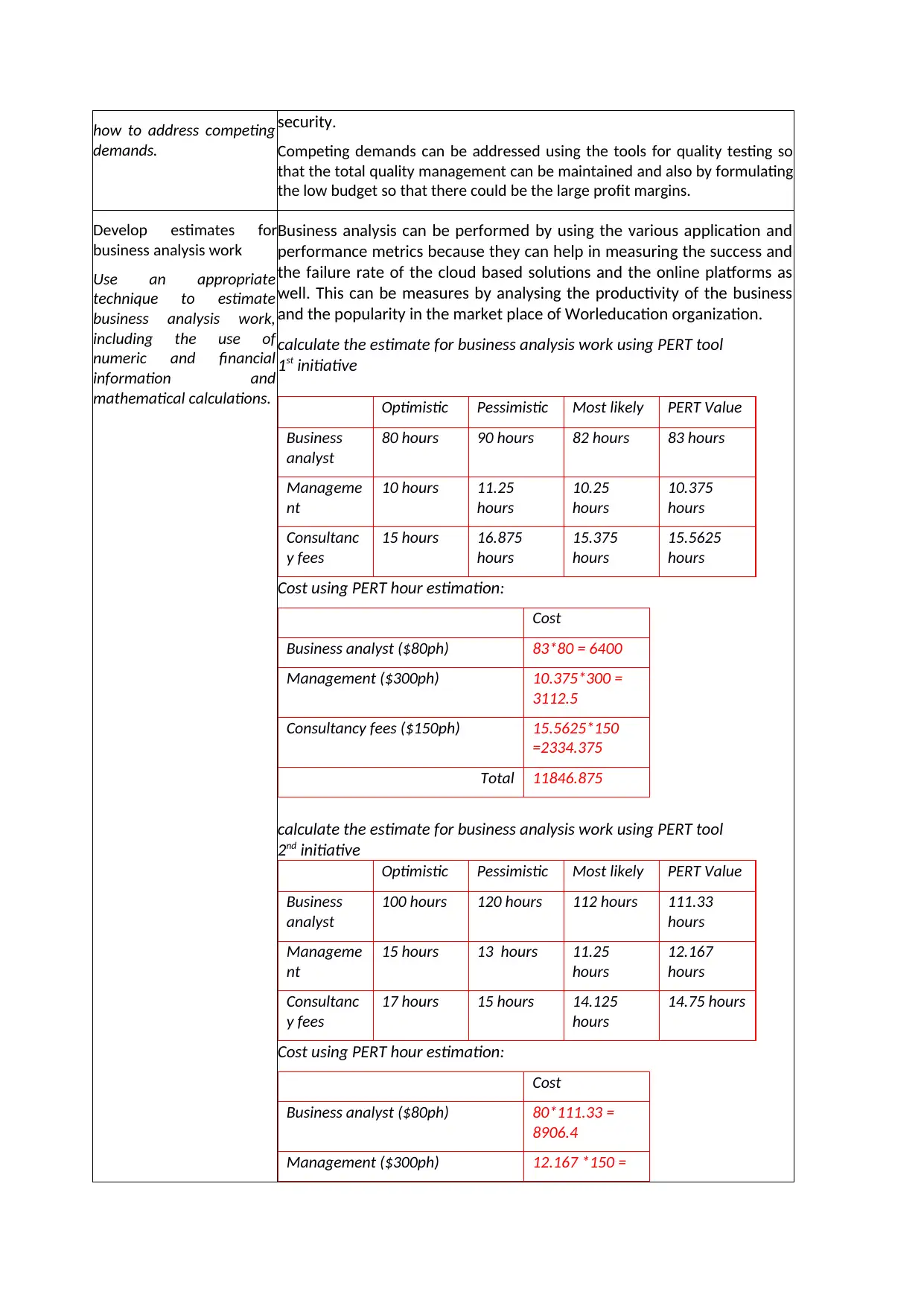
how to address competing
demands.
security.
Competing demands can be addressed using the tools for quality testing so
that the total quality management can be maintained and also by formulating
the low budget so that there could be the large profit margins.
Develop estimates for
business analysis work
Use an appropriate
technique to estimate
business analysis work,
including the use of
numeric and financial
information and
mathematical calculations.
Business analysis can be performed by using the various application and
performance metrics because they can help in measuring the success and
the failure rate of the cloud based solutions and the online platforms as
well. This can be measures by analysing the productivity of the business
and the popularity in the market place of Worleducation organization.
calculate the estimate for business analysis work using PERT tool
1st initiative
Optimistic Pessimistic Most likely PERT Value
Business
analyst
80 hours 90 hours 82 hours 83 hours
Manageme
nt
10 hours 11.25
hours
10.25
hours
10.375
hours
Consultanc
y fees
15 hours 16.875
hours
15.375
hours
15.5625
hours
Cost using PERT hour estimation:
Cost
Business analyst ($80ph) 83*80 = 6400
Management ($300ph) 10.375*300 =
3112.5
Consultancy fees ($150ph) 15.5625*150
=2334.375
Total 11846.875
calculate the estimate for business analysis work using PERT tool
2nd initiative
Optimistic Pessimistic Most likely PERT Value
Business
analyst
100 hours 120 hours 112 hours 111.33
hours
Manageme
nt
15 hours 13 hours 11.25
hours
12.167
hours
Consultanc
y fees
17 hours 15 hours 14.125
hours
14.75 hours
Cost using PERT hour estimation:
Cost
Business analyst ($80ph) 80*111.33 =
8906.4
Management ($300ph) 12.167 *150 =
demands.
security.
Competing demands can be addressed using the tools for quality testing so
that the total quality management can be maintained and also by formulating
the low budget so that there could be the large profit margins.
Develop estimates for
business analysis work
Use an appropriate
technique to estimate
business analysis work,
including the use of
numeric and financial
information and
mathematical calculations.
Business analysis can be performed by using the various application and
performance metrics because they can help in measuring the success and
the failure rate of the cloud based solutions and the online platforms as
well. This can be measures by analysing the productivity of the business
and the popularity in the market place of Worleducation organization.
calculate the estimate for business analysis work using PERT tool
1st initiative
Optimistic Pessimistic Most likely PERT Value
Business
analyst
80 hours 90 hours 82 hours 83 hours
Manageme
nt
10 hours 11.25
hours
10.25
hours
10.375
hours
Consultanc
y fees
15 hours 16.875
hours
15.375
hours
15.5625
hours
Cost using PERT hour estimation:
Cost
Business analyst ($80ph) 83*80 = 6400
Management ($300ph) 10.375*300 =
3112.5
Consultancy fees ($150ph) 15.5625*150
=2334.375
Total 11846.875
calculate the estimate for business analysis work using PERT tool
2nd initiative
Optimistic Pessimistic Most likely PERT Value
Business
analyst
100 hours 120 hours 112 hours 111.33
hours
Manageme
nt
15 hours 13 hours 11.25
hours
12.167
hours
Consultanc
y fees
17 hours 15 hours 14.125
hours
14.75 hours
Cost using PERT hour estimation:
Cost
Business analyst ($80ph) 80*111.33 =
8906.4
Management ($300ph) 12.167 *150 =
⊘ This is a preview!⊘
Do you want full access?
Subscribe today to unlock all pages.

Trusted by 1+ million students worldwide
1 out of 18
Related Documents
Your All-in-One AI-Powered Toolkit for Academic Success.
+13062052269
info@desklib.com
Available 24*7 on WhatsApp / Email
![[object Object]](/_next/static/media/star-bottom.7253800d.svg)
Unlock your academic potential
Copyright © 2020–2025 A2Z Services. All Rights Reserved. Developed and managed by ZUCOL.





